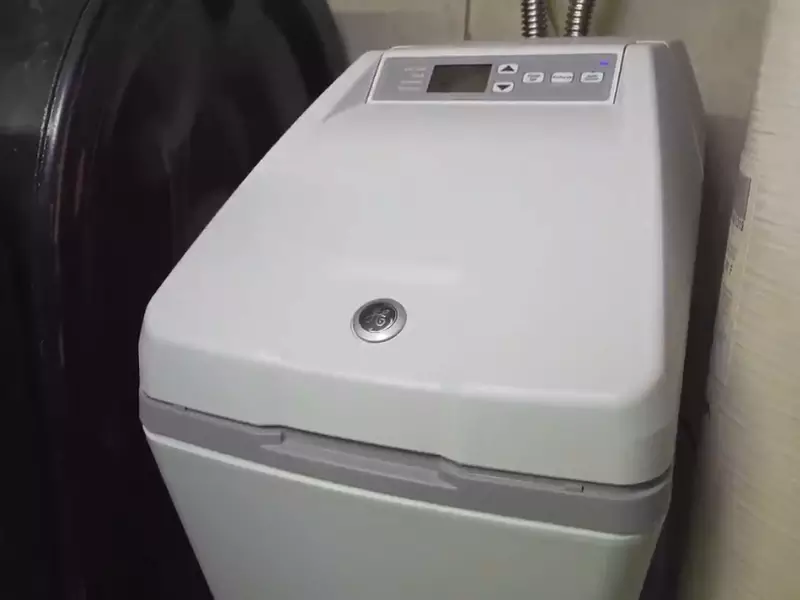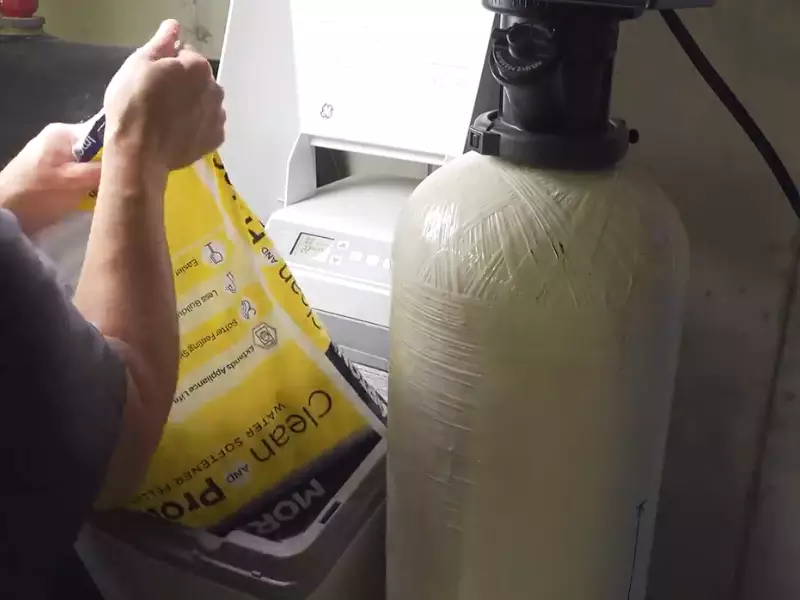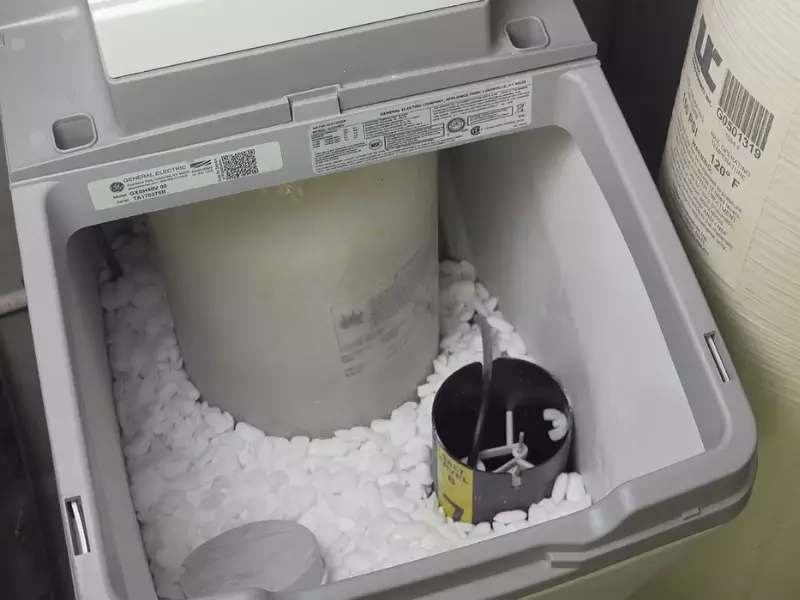Well water has long been a reliable source of water for many households. But like other water sources, it has its challenges. One notable challenge many homeowners face is the sensation of sliminess after softening their well water.
The sensation can be attributed to the process of water softening, where hard water minerals are exchanged for sodium ions. This process makes the water feel smoother, sometimes interpreted as slimy.
However, there’s more to this sensation than meets the eye. The softening process transforms the chemical composition of water, giving it a different texture when in contact with the skin.
What is Water Softening?
Water softening is the process of removing calcium, magnesium, and other metal cations from hard water. These minerals are responsible for the hardness of water, leading to issues like soap scum, scale buildup, and pipe corrosion.

How the Softening Process Works
As water flows through the ion exchange resin, calcium and magnesium ions are replaced with sodium ions. This exchange transforms hard water into soft water.
Key Components of a Water Softener
Ion Exchange Resin
The heart of any water softener system is the ion exchange resin. These are small, polystyrene beads charged with a sodium ion. When water flows over these beads, the undesirable hard minerals, mainly calcium and magnesium, are attracted to them.
Simultaneously, the softer sodium ions are released into the water. Over time, as more hard water is treated, the resin beads become saturated with these hard minerals and need regeneration.
Brine Tank
A water softener’s brine tank is where salt gets added, which is instrumental in the regeneration process. When the resin beads become saturated with hard minerals, a high concentration of saltwater, or brine, is flushed through the system.
This salt-rich solution effectively “cleans” the resin beads, swapping the hard minerals back out for sodium ions. It’s essential to refill the brine tank with salt periodically, depending on your water usage and hardness.
Control Valve
This component is like the water softener’s brain. The control valve measures water usage and determines when regeneration is needed. There are two main types of control valves:
- Timer-based: These valves regenerate at preset times, regardless of actual water usage. It’s less efficient but often more affordable.
- Demand-initiated regeneration: These are more advanced and only regenerate based on the actual amount of water used. They’re more efficient and better suited for households with fluctuating water needs.

Science Behind Slimy Feeling
Composition of Hard Water
Water hardness is primarily determined by the amount of calcium and magnesium dissolved in it. These minerals come from rock formations, specifically limestone, that the water might flow through underground.
High levels of these minerals can create challenges, such as interfering with soap’s ability to lather and leaving mineral deposits behind on surfaces.
Role of Sodium in Softened Water
The exchange of calcium and magnesium for sodium is fundamental to the softening process. Sodium ions, being much more soluble in water, don’t cause the same issues that calcium and magnesium do.
However, they have their own unique properties, one of which is the silky or slimy feeling they can impart to water. This sensation is often more pronounced because sodium doesn’t readily combine with soap, leading to a more slippery feeling when washing.
Osmotic Effects on Skin
One reason softened water feels different on the skin is due to its osmotic effect. Hard water tends to draw moisture out of the skin, leaving it feeling dry and rough. Softened water, on the other hand, helps in retaining the skin’s natural moisture. With the removal of hard minerals and the introduction of sodium, the water becomes more harmonious with the skin’s natural oils, leading to that smooth feeling.
Benefits of Softened Water
Extended Appliance Lifespan
When hard water flows through appliances, it can leave calcium and magnesium deposits. Over time, these deposits build up, leading to decreased efficiency and potential damage. By using softened water, these mineral deposits are significantly reduced, ensuring appliances last longer and operate at peak performance.
Reduced Scale Buildup
Those stubborn white spots on faucets, showerheads, and dishes? That’s scale buildup. Softened water dramatically reduces this nuisance, making cleaning tasks easier and leaving surfaces spot-free.
Improved Soap Lathering
One of the first things people notice with softened water is how much better their soap and detergent perform. Hard minerals in water hinder the soap’s ability to create lather, meaning you have to use more to get the same effect. Softened water allows for a richer lather with less soap, leading to cost savings and better cleaning power.
Skin and Hair Health
The benefits extend beyond household chores. People often find their skin feels softer and looks healthier after switching to softened water. This is because it’s gentler on the skin, not stripping away as much of its natural oil. Hair also benefits, with many reporting it feels softer and is more manageable after washing with soft water.

Misinterpretation of “Slimy” Sensation
Difference between Sliminess and Silkiness
It’s crucial to clarify what people often describe as slimy. Softened water preserves the skin’s natural oils, creating a sensation that’s more accurately described as silky rather than slimy. This feeling is simply a sign that the skin isn’t being stripped of its essential oils.
Softened Water vs. Soap Residue
Some think that the slimy sensation is due to soap not being adequately rinsed off. However, the opposite is true. Soft water ensures more thorough rinsing, washing away soap more effectively than hard water. The smooth feeling post-shower is the result of the water’s changed composition, not leftover soap.
Potential Issues & Solutions
Excess Sodium
While sodium plays a vital role in the water softening process, an overabundance can heighten the slimy sensation. It’s crucial to ensure the softener settings are accurate to prevent over-saturation. If sodium levels concern you, consider testing your water to ensure it’s within a safe range.
Fine-Tuning Softener Settings
Your water’s hardness level and the amount of water you use are pivotal in determining the optimal softener settings. Periodically checking and adjusting settings can help maintain the perfect balance, giving you all the benefits of softened water without an overly pronounced slimy sensation.
Exploring Alternative Softening Methods
If sodium becomes a concern or if you’re seeking different softening solutions, there are alternatives. Potassium chloride is a popular option. It works similarly to traditional salt but without adding sodium to the water. Another option is a salt-free water conditioner, which conditions water without using salt or ion exchange.
Care & Maintenance
Ensuring your water softener operates efficiently is key to reaping its benefits. This means periodically checking the system for any issues. High-quality salt is essential as inferior salt can have impurities that reduce the efficiency of the softening process.
Also, pay attention to any changes in water quality or feel. These could be signs that your system needs servicing or adjusting.
Frequently Asked Questions
Why is softened water better for appliances?
Soft water prevents scale deposits which can clog and damage appliances, ensuring they run efficiently and last longer.
Can you drink softened water?
Yes, softened water is generally safe to drink, though some might find the sodium content a bit high. It’s always good to have your water tested for specific concerns.
Are there alternatives to sodium-based softeners?
Absolutely! Potassium chloride is a popular alternative, though it can be pricier than traditional salt.
Conclusion
Softened well water provides a plethora of benefits, from increased appliance lifespan to improved skin health. It’s essential to recognize the root causes behind the ‘slimy’ sensation and understand it’s often a hallmark of quality softening.
By maintaining your system and making minor adjustments, you can enjoy the perks of soft water without the slippery side effects.